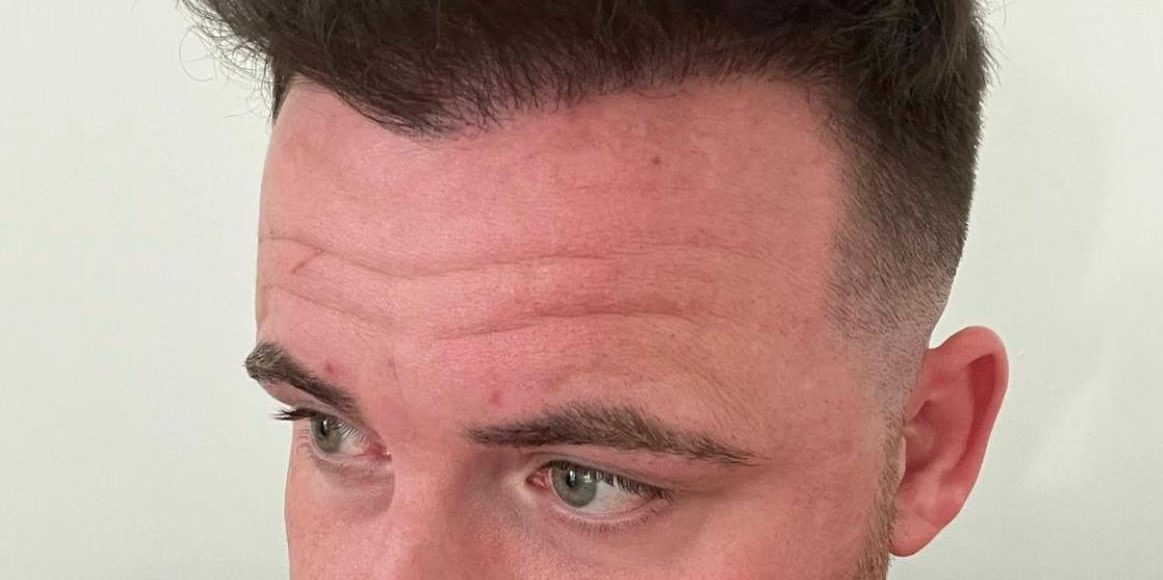
Can You Undergo a Hair Transplant With Long Hair?

Darren Connell former patient
Have you considered a hair transplant, but you have long hair?
Conventionally, hair transplant procedures such as follicular unit extraction (FUE) and follicular unit transplantation (FUT) involve harvesting hair follicles out of the donor region(often the back or sides of the head) and implanting them in the balding area.
This usually requires the surgeon to shave your head because retrieving and implanting shorter shaved hairs is easier. Hair may be extracted without shaving, and our hair transplant facility is now equipped to undertake these procedures. This allows patients to return to work or social activities sooner following their transplant without hiding a short haircut.
In this article, we shall understand how a hair transplant with long hair is done, the myths involved, the advantages and disadvantages, the preparations involved, and where to get a hair transplant in the UK.
Let’s first understand the types of hair transplants available.
Overview of Hair Transplant Techniques
Hair transplant techniques have evolved significantly, offering effective solutions for hair loss. The primary methods are Follicular Unit Extraction (FUE) and Follicular Unit Transplantation (FUT).
FUE involves getting the individual follicular units from the donor area, while FUT involves removing a strip of scalp containing hair follicles. Both techniques allow for the transplantation of healthy hair follicles into balding or thinning areas, resulting in natural-looking hair growth. Advanced technology and skilled surgeons have made these procedures minimally invasive with shorter recovery times, providing hope for individuals seeking lasting solutions to hair loss.
So, how about individuals with long hair?
Patients undergoing traditional hair transplantation with FUE methods benefit from the absence of a lengthy, linear transplant scar. However, they may still experience an unpleasant period of short hair growing back into the donor zone.
Hair operations needed to figure out how to extract those individual follicle transplants without cutting the hair short. Hair surgeons are always innovating and enhancing the techniques that produce exceptional outcomes. A woman can now receive hair transplantation for thinning hair using a no-shave FUE procedure.
Learn why long-haired patients are increasingly choosing permanent, natural-looking hair transplant surgery.
Types of long hair transplants
Alternative treatments are available for patients with longer hair in addition to traditional FUT and FUE. These include the following:
-
- Long hair transplant – When hair follicles are extracted and transplanted, the hair shafts remain intact.
- Unshaven FUE (UFUE) —When the grafts are implanted, the recipient area is left mostly or entirely shaven, which helps to conceal your hair transplant.
How Does a Long Hair Transplant Work?
For patients with long hair, a standard FUT or FUE is typically an option for covering bald areas, lowering receding hairlines, and increasing hair density if the hair has thinned to the point that the scalp can be visible. In typical hair transplants, the donor hair is taken in its entirety, but the recipient area is usually shaved to allow the hair follicles to be transplanted more easily.
How are Long Hair Grafts Extracted?
In a long hair FUE hair transplant, the hair follicles are harvested first; then, the hair shafts are cut 2 – 8 cm (rather than 2 mm in a standard FUE treatment) before being placed back into the scalp. An assistant uses upward traction or a narrow sterile stick to keep the hair aside, while the surgeon punches the follicle with their right hand and moves the hair with forceps in their left.
These transplanted hairs are long enough to hide the implantation sites, which will scab over in the days after the procedure.
Myth Busting: Hair Transplants and Long Hair
Let’s now discuss the myths about long hair transplants that have hindered most people from achieving their dream look.
Long Hair and Donor Site Accessibility
Contrary to popular belief, long hair doesn’t hinder the extraction process during a hair transplant. Skilled surgeons utilise specialised techniques such as lateral slits or the trimming of donor hair to ensure accessibility to the donor site while preserving the overall appearance of long hair. These methods allow for precise extraction of follicular units without compromising the length or density of surrounding hair.
Long Hair and Post-Transplant Care
After undergoing a hair transplant with long hair, proper post-transplant care is crucial for optimal results. This includes gentle washing and drying of the hair to avoid dislodging grafts and avoiding activities that may strain the transplanted area. Additionally, incorporating a hair care routine that promotes scalp health and hair growth can help maintain long-term results.
Dispelling Concerns about Scarring with Long Hair
Worries about visible scarring with long hair post-transplant are unfounded. Scarring from modern hair transplant techniques is typically minimal and easily concealed, even with longer hair. Surgeons employ meticulous closure techniques and precise incision placement to minimise scarring, ensuring a natural and seamless appearance, even with longer hairstyles.
What are the Advantages of Long Hair Transplant?
So, what are the benefits of a long hair transplant over a traditional one?
Long Hair Covers Transplant
Many people are scared of getting a hair transplant because of the visible indicators of the treatment, including a shaven scalp and hair transplant scabbing. A long hair transplant’s main benefit is that these symptoms are less noticeable and frequently go unnoticed. Either all hair is left unshaven or merely sparsely shaved areas that are concealable with styling. Within days, patients can frequently resume their daily activities and jobs.
Long Hair Transplant Have immediate Outcomes
In just a few days, you might be able to resume your regular activities without anyone realising you had a hair transplant if you opt for an unshaven hair transplant. You can hide redness and scabbing under your hair and keep your original haircut. The complete outcomes of conventional FUE are often seen after six months to a year. With a lengthy hair transplant, patients can see their final hair growth outcomes as soon as possible or about a year after the transplant.
Long Hair Offer Improved Follicle Positioning and Selection
Long hair transplants assist surgeons in selecting the optimum hair follicles to match the area successfully. This is possible in areas like beards, sideburns, or eyebrows where hair curls and weight are essential for seamless transplanting. Additionally, this lowers the likelihood of surgeons implanting hair follicles in the incorrect direction, which can lead to abnormal hairs developing away from the main body of hair. Skin cysts and benign patches associated with inflammation may also result from this.
Reduced Chance of Over-Harvesting
According to certain assessments, since the surgeon can more easily notice the hair loss in the donor area, there may be less chance of overharvesting follicles from this location. This is only considered when patients have had extreme overharvesting in the past or when the donor area is extremely tiny in cases of progressive hair loss. A shaved donor area is the standard of care for qualified hair transplant surgeons.
Disadvantages of a Hair Transplant with Long Hair
Though more and more people are choosing to undergo lengthy hair transplants, some patients may be put off by the more involved unshaven FUE process due to many disadvantages.
Long Hair Transplant Offers Process Complexity
A long hair transplant operation is significantly more challenging than a typical hair transplant. The long, unshaven hairs can knot and tangle, making extracting the follicle more difficult since the strands become entangled. The blood that swiftly clots in the long hair from the punch holes exacerbates this. Patients may find it more difficult to select the appropriate clinic because fewer doctors are qualified to do the surgery.
May Take a Long to Recover After Hair Transplantation
Patients may have mild symptoms, including soreness, post-hair transplant edema, or redness in the first few days after the treatment, much like a typical transplant. They will go away in the days following the surgery and are merely transient. Your doctor can recommend anti-inflammatories or medications to manage these symptoms. You can also talk about particular post-transplant drugs, such as minoxidil, that your physician might prescribe.
Conclusion
In conclusion, undergoing a hair transplant with long hair is feasible and offers significant advantages. From concealing the transplant process to enjoying immediate outcomes, long hair transplants provide a seamless and natural appearance. Concerns about scarring and post-transplant care are addressed, ensuring optimal results.
For those considering this option, seeking professional advice and exploring treatment options are crucial.
At Merchant City Medical Group, our UK and European experts specialise in advanced procedures like unshaven FUE, offering tailored solutions for individuals with long hair.
Don’t let long hair deter you from achieving the hair you desire. Schedule a free consultation today.

